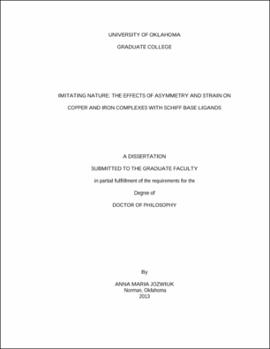| dc.contributor.advisor | Houser, Robert P.||Glatzhofer, Daniel T. | |
| dc.creator | Jozwiuk, Anna Maria | |
| dc.date.accessioned | 2019-04-27T21:41:27Z | |
| dc.date.available | 2019-04-27T21:41:27Z | |
| dc.date.issued | 2013 | |
| dc.identifier | 9995598702042 | |
| dc.identifier.uri | https://hdl.handle.net/11244/319347 | |
| dc.description.abstract | Metalloenzymes are incredibly complex "machines" which catalyze reactions essential for life. Metal ions are found in more than half of all known proteins; particularly, copper and iron are abundant in active sites performing complex reactions. The coordination environment around the metal center itself drives the metal ion to undergo biospecific, highly optimized, and selective reactions, such as the oxidation of methane to methanol, splitting of water, or generation of ammonia. Most of the active sites are asymmetric and some metal ions are forced into strained geometries. These factors facilitate catalysis and electronic tuning. Against this background, aspects of strain and asymmetry were probed in model complexes with iron and copper ions. Utilizing Schiff base ligands as molecules that can be easily manipulated in steric and electronic properties via building block assembly, iron and copper complexes were synthesized. | |
| dc.description.abstract | The ferric diiron complexes [(FeL)2(µ-OH)]+, [(FeLNO2)2(µ-OH)]+ and [(FeL)2(µ-O)] (L = 2,2'-(2-Methyl-2-(pyridin-2-yl)propane-1,3-diyl)bis(azanediyl)- bis(methylene)- diphenolate and LNO2 = 2,2'-(2-Methyl-2-(pyridin-2-yl)propane-1,3-diyl bis(azanediyl)- bis(methylene)bis(4-nitrophenolate)) show structural and spectroscopic similarities to bridged hydr(oxo)diiron containing active sites of metalloproteins. Unique properties of the ligand create asymmetry of the diiron unit as well as bent Fe-O-Fe structures. The stability of the bio-relevant mixed-valence state was investigated by electrochemical means, as well as by chemical reduction. Unfortunately, the Fe(II)/Fe(III) state is not accessible in the complex presented here. However, a mechanistic pathway of decomposition is suggested and an interesting feature of the ligand used in this study may allow for stabilization and characterization of the mixed-valence state, and even further, it may reveal the role of a unique amino acid residue interaction with the diiron site in rubrerythrin. | |
| dc.description.abstract | Two copper(II) complexes (dimeric [Cu(HL2)]2(ClO4)4 and monomeric [Cu(L3)](ClO4)2) with novel, related Schiff base ligands (HL2 = 2-((2-Methyl-2-(pyridin-2-yl)-3-(pyridin-2-ylmethyleneamino)propylimino)- methyl)phenol and L3 = 2-Methyl-2-(pyridin-2-yl)-N1,N3-bis(pyridin-2-ylmethylene)propane-1,3-diamine) were synthesized and characterized. One series of studies revealed a synthesis plan for asymmetric Schiff base complexes through unique properties of the ligand. It was shown that intermediate electronic tuning of the copper(II) complex is possible in the asymmetric complex compared to the fully symmetric analogues. | |
| dc.description.abstract | In another study, the aspect of geometrical strain was investigated. The distorted copper(II) complexes [CuL5-gem] and [CuL5-ortho] (L5-gem = Pseudo-gem-N,N'-bissalicylidene-4,15-diamino[2.2]paracyclophane and L5-ortho = Pseudo-ortho-N,N'-bissalicylidene-4,16-diamino[2.2]paracyclophane) which were obtained in this study are reminiscent of blue copper protein centers which allow for fast electron transfer by having geometries between tetrahedral and square planar. Structural and spectroscopic studies show that strain is present in both the solid and solution state. The distortion causes a shift in redox potential of about half a volt compared to square planar analogues. Initial studies revealed that strained complexes with other divalent metal ions are possible to form (e.g. [CoL5-gem] was isolated and characterized). Strained complexes are interesting for catalysis as geometrical strain may enhance reactivity. | |
| dc.format.extent | 243 pages | |
| dc.format.medium | application.pdf | |
| dc.language | en_US | |
| dc.relation.requires | Adobe Acrobat Reader | |
| dc.subject | Metalloenzymes | |
| dc.subject | Ligands | |
| dc.subject | Metalloproteins | |
| dc.title | Imitating Nature: The Effects of Asymmetry and Strain on Copper and Iron Complexes with Schiff Base Ligands | |
| dc.type | text | |
| dc.type | document | |
| dc.thesis.degree | Ph.D. | |
| ou.group | College of Arts and Sciences::Department of Chemistry and Biochemistry | |
